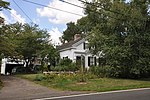Regicides Trail
Blue-Blazed TrailsGeography of New Haven, ConnecticutHamden, ConnecticutLandforms of New Haven County, ConnecticutMetacomet Ridge, Connecticut ... and 3 more
Mountains of ConnecticutProtected areas of New Haven County, ConnecticutTourist attractions in New Haven, Connecticut

Regicides Trail is a Blue-Blazed hiking trail, about 7 miles (11 km) long, roughly following the edge of a diabase, or traprock, cliff northwest of New Haven, Connecticut. It is named for two regicides, Edward Whalley and his son-in-law William Goffe, who signed the death warrant of King Charles I of England. Upon the restoration of Charles II to the throne and the persecution of the regicides, the pair hid in Judges Cave near the south end of the trail in 1660. The Regicides is widely known to be one of the most technical trails within the CT Blue-Blazed trail system.
Excerpt from the Wikipedia article Regicides Trail (License: CC BY-SA 3.0, Authors, Images).Regicides Trail
Paradise Avenue,
Geographical coordinates (GPS) Address Nearby Places Show on map
Geographical coordinates (GPS)
| Latitude | Longitude |
|---|---|
| N 41.372777777778 ° | E -72.969722222222 ° |
Address
West Rock Ridge State Park
Paradise Avenue
06514
Connecticut, United States
Open on Google Maps







